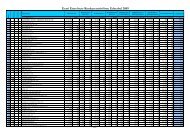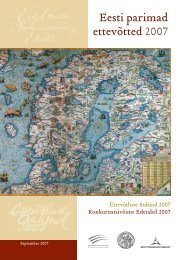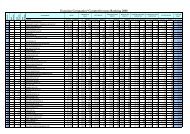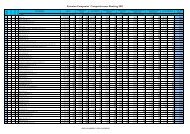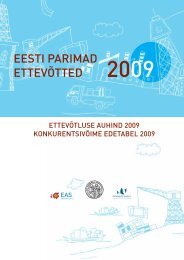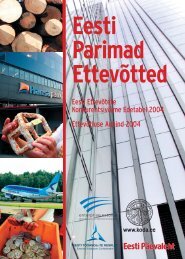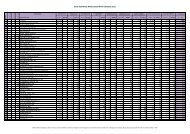TOP ESTONIAN ENTERPRISES
TOP ESTONIAN ENTERPRISES
TOP ESTONIAN ENTERPRISES
You also want an ePaper? Increase the reach of your titles
YUMPU automatically turns print PDFs into web optimized ePapers that Google loves.
Photo: Tuulum<br />
in salary and made the real growth of economy<br />
negative. In 2008 the food products and residential<br />
expenses (14.4% and 15.8% respectively) had<br />
the faster rise in prices than average.<br />
The goods export increased in 2008 in the nominal<br />
price by 5.5% and reached 132.5 billion<br />
kroons. The growth remained smaller than expected<br />
and this also partly due to the world’s<br />
economic crisis. On the other hand, the rise in<br />
price of labour and others caused the rise in<br />
price of export (export price index 4.2%) which<br />
decreased our competitiveness at the foreign<br />
markets. The companies of the processing industry<br />
exported 54% of its production which is<br />
3% points less than in 2007. The goods were exported<br />
to 160 countries, whereby the main target<br />
countries were still Finland, Sweden and<br />
Russia. The percentage of the countries of the<br />
European Union in export was 70%. The export<br />
of goods was greatly based on the imported raw<br />
material and half-products which is proven by<br />
the fact that the major export group was again<br />
the plant and equipment, by making about one<br />
fifth of the export sales.<br />
The goods import in 2008 made total of 169.9 billion<br />
kroons by decreasing 4.9% compared to the<br />
previous year (in nominal prices). Thanks to the<br />
de crease of import the balance sheet of the trade<br />
in goods considerably improved which has been<br />
in big minus through the years. Now the deficit<br />
made 37.4 billion kroons which is lower of the<br />
record of 2007 by 15.8 billion kroons. The highest<br />
negative balance sheet was in the trade of mineral<br />
products (about 12 billion kroons). At the same<br />
time the highest positive balance was in the trade<br />
of wood and wood products (about 7 billion EEK).<br />
The balance sheet of services was traditionally<br />
positive in 2008, whereby both export and import<br />
increased. The services were exported for<br />
55 billion kroons (in 2007 50 billion kroons) and<br />
imported for 38 billion kroons (in 2007 35 billion<br />
kroons). The positive balance sheet of services<br />
decreased in its turn the chronic deficit of current<br />
account which now made 23.4 billion<br />
kroons, i.e. 9.4% as to the GDP (in 2007 43.5 billion<br />
kroons and 18.2%).<br />
The fast increase in salaries in 2007 (20.5%) expressed<br />
the after-effect also on the salary of<br />
2008 (adjustment between the fields of activities).<br />
Regardless of the economic recession the<br />
average salary increased to 12 818 kroons according<br />
to the initial data, i.e. 13.1%. The 10.4%<br />
rise in consumer prices also had some impact<br />
on the faster rise in price than labour productivity.<br />
As a result of the latter the real salary increased<br />
by “only“ 2.7% (13% in 2007).<br />
The real estate market had the major fall already<br />
in 2007 (the number of transactions fell<br />
by 17%) which promised to hope that in 2008 we<br />
can already talk about the stabilization of the<br />
market. This was not the case and now we can<br />
state that the bottom was still far in IV quarter<br />
of 2007. The economic crisis also surely added<br />
to the continuing fall. In the year ended 34.4<br />
thousand notarised real estate transactions<br />
were concluded with the total cost of 33.9 million<br />
kroons. It should be noted that in 2006 and<br />
2007 60.2 and 50 thousand transactions were<br />
concluded respectively. Thus the shrinking of<br />
the real estate market in 2008 was even more<br />
intensive than in 2007. The latter is confirmed<br />
also by changing of the average cost of real<br />
estate transaction – if in 2007 this was 1170<br />
thousand kroons, then in 2008 985 thousand<br />
kroons, i.e. 16% less (in 2007 the fall in the cost<br />
was 4.5%).<br />
The expansion of the loan market continued in<br />
2008, but considerably slower than in 2007. The<br />
total loan portfolio of the commercial banks was<br />
260.1 billion kroons at the year end, by increasing<br />
20.6 billion kroons, i.e. 8.6% with a year. A<br />
year earlier the relevant numbers were 62 billion<br />
kroons and 35%. The best times of expansion<br />
of the loan market had passed this time.<br />
The loan balance of the citizens (without leasing)<br />
increased 120.7 billion kroons by the year<br />
end, being 109 billion kroons a year earlier. The<br />
loan growth decreased approximately three<br />
times compared to 2007 (28 billion kroons). In<br />
the year ended the deposits of the citizens increased<br />
6.1 billion kroons in the banks and<br />
made total of 59.8 billion kroons at the year end.<br />
The deposits of the citizens make about half of<br />
their loan portfolio and 2/3 of their annual salary<br />
fund.<br />
The activities of the companies in 2008 are described<br />
by the following data: industrial production<br />
(volume index) fell by 6.5%, retail of<br />
goods (volume index) decreased by 3% and the<br />
cost of construction works carried out with own<br />
forces in current price decreased by 9.1%. As to<br />
the industry and trade the second half-year was<br />
considerably worse than the first.<br />
It could be added that the balance of payments<br />
of 2008 with 10.3 billion kroons and the state<br />
budget with 5.2 billion kroons remained in<br />
minus.<br />
87



